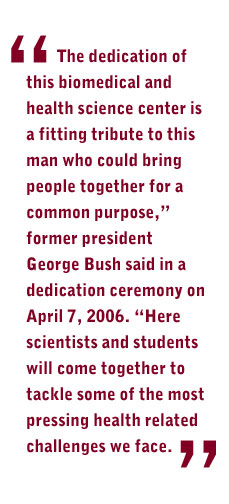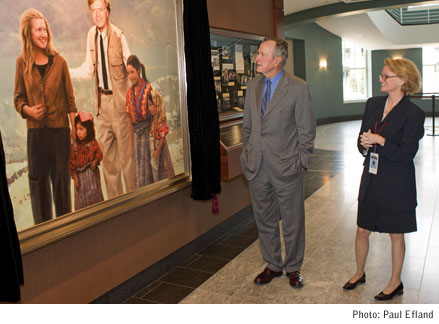


Where Talents Converge, By Plan and By Chance
by Carole VanSickle
Intro
| Creating Synergy
| A Powerful Lineup
| Precious Resources

![]()
Little Critters Driving a Big Machine

Creating Synergy
Consider neuroscience, which incorporates psychology, medicine, engineering and mathematics in order to study the brain. Jim Lauderdale (a professor of cellular biology) and Andrew Sornborger (a professor of mathematics and engineering) illustrate how neuroscience thrives on interdisciplinary collaboration. “I use live model organisms — mice and zebrafish, for example — to study how we sense the world around us. As part of this research, we look for very small changes in brain activity following certain stimuli, such as flashing lights or exposure to pungent compounds like ginger or peppermint,” said Lauderdale, who hopes to use the information to develop therapies for chronic pain and a genetic defect that causes early cataracts and glaucoma. “If we understand the circuits that govern pain response and the ways in which circuits in the retina respond to this genetic defect or even to just plain aging, we can go in and fix it. But to understand it, we’ve got to be able to see it, and that’s where Andrew comes in.”
Sornborger specializes in the analysis of “noisy” data — picking out patterns in complex neurological images of Lauderdale’s test animals. “The brain is a noisy place,” Sornborger said. “That animal is alive — the whole time we’re working with its responses to a specific stimulus, in the background its brain is doing lots of other things — perhaps thinking ‘What am I doing here and why is this guy blinking lights at me?’ among them. I help distinguish responses to stimulation from the noise.”

Former President George Bush and Nancy Coverdell admire a portrait of late senator Paul D. Coverdell engaged in Peace Corps work.
With his joint appointments in mathematics and engineering, Sornborger’s expertise is an excellent fit with the Coverdell community. “I already am involved in several different kinds of imaging collaborations with various people within [several of the units to be housed in Coverdell],” he said. “My bench is right next to Jim’s and just a few feet away from several other co-investigators, which is great because now we can get together easily and just run downstairs to try new things out in the bioimaging facility.” Both professors are members of the Developmental Biology Group (DBG) and the Biomedical and Health Sciences Institute (BHSI) in the Coverdell facility.
Moreover, “as we develop new techniques to look at the aging retina and other kinds of tissues,” said Lauderdale, “I think that Andrew’s skills will become vital to more and more people’s research.” Sornborger has already begun working with several other members of the Coverdell community who are also interested in using neurobiology to investigate everything from eating behaviors to epilepsy.
Strand, who holds joint appointments in entomology and genetics, is another example of the facility’s finely orchestrated mix of disciplines. He works with statisticians, other entomologists, immunologists and developmental biologists to study, for example, the ways in which insects can affect the spread of disease. In a project to study malaria, all three primary investigators are members of multiple units in the Coverdell community. While Strand examines interactions between the malaria parasite and its host — a mosquito — colleague Don Champagne focuses on the insect’s salivary proteins and the ways in which they permit its bite to infect a human and Mark Brown investigates malarial infiltration of the insect’s reproductive cycle.
Champagne and Brown are also entomology professors, but each focus on a different aspect of malaria — not just on the bug that carries it. “The whole time we’re looking at the same processes, but in different directions,” said Strand. “And it is all pertinent to populations and problems that nearly every member of the Center for Tropical and Emerging Global Diseases (CTEGD) is involved with in some form or fashion, whether through population studies, shared bioassays or disease-transmission studies. Being here puts me in close proximity to investigators across the spectrum.”
Intro
| Creating Synergy
| A Powerful Lineup
| Precious Resources
For comments or for information please e-mail: rcomm@uga.edu
To contact the webmaster please email: ovprweb@uga.edu
![]()